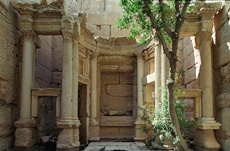UN chief appalled at IS destruction of Palmyra temple
25 Aug 2015
UN secretary general Ban Ki-moon said on Monday he was appalled by the demolition of a temple in Syria's ancient Palmyra by the Islamic State.
 In what could be the worst attack on a cultural site since the destruction of the Bamiyan Buddhist statutes in Afghanistan by the Taliban in 2011, Islamic State militants packed explosives in the Baal Shamin temple and blew up the shrine on Sunday, Syria's antiquities chief said.
In what could be the worst attack on a cultural site since the destruction of the Bamiyan Buddhist statutes in Afghanistan by the Taliban in 2011, Islamic State militants packed explosives in the Baal Shamin temple and blew up the shrine on Sunday, Syria's antiquities chief said.
Ban also voiced outrage over the murder of Khaled al-Assaad, the retired chief archeologist at Palmyra, whose body was mutilated after he was beheaded on 18 August.
"These barbaric acts of terror join a long list of crimes committed over the past four years in Syria against its civilian population and heritage," Ban said in a statement.
Palmyra is listed as a world heritage site by the UN cultural body Unesco, and Ban recalled that destroying world cultural sites was a war crime.
The UN chief called on world governments to "unite and act swiftly to put a stop to this terrorist activity''.
The Director-General of the United Nations Educational, Scientific and Cultural Organization (Unesco), Irina Bokova, declared Monday that extremists ''cannot silence history'', condemning the destruction of Baalshamin.
''The systematic destruction of cultural symbols embodying Syrian cultural diversity reveals the true intent of such attacks, which is to deprive the Syrian people of its knowledge, its identity and history,'' Bokova declared in a press release.
''One week after the killing of Professor Khaled al-Assaad, the archaeologist who had looked after Palmyra's ruins for four decades, this destruction is a new war crime and an immense loss for the Syrian people and for humanity,'' she added.
According to Unesco, Baalshamin temple was built nearly 2,000 years ago, and bears witness to the depth of the pre-Islamic history of the country. According to several reports, the building was blown up on Sunday. Its cella, or inner area, was severely damaged, and followed by the collapse of the surrounding columns.
The structure of the Baalshamin temple dates to the Roman era. It was erected in the first century AD and further enlarged by Roman emperor Hadrian. The temple was one of the most important and best preserved buildings in Palmyra. It is part of the larger site of Palmyra, one of the most important cultural centres of the ancient world, famed for its Greco-Roman monumental ruins, repeatedly targeted by Da'esh [also referred to as the Islamic State of Iraq and the Levant, or ISIL] since May 2015.
The art and architecture of Palmyra, standing at the crossroads of several civilizations, has been a symbol of the complexity and wealth of the Syrian identity and history, Mrs. Bokova continued.
''Extremists seek to destroy this diversity and richness, and I call on the international community to stand united against this persistent cultural cleansing. Da'esh is killing people and destroying sites, but cannot silence history and will ultimately fail to erase this great culture from the memory of the world. Despite the obstacles and fanaticism, human creativity will prevail, buildings and sites will be rehabilitated, and some will be rebuilt.''
Such acts are war crimes and their perpetrators must be accountable for their actions, the Director-General added.













.jpg)






.jpg)









